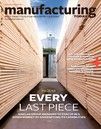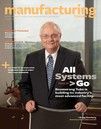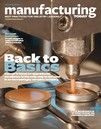A Survival Model For The Small Restaurateur
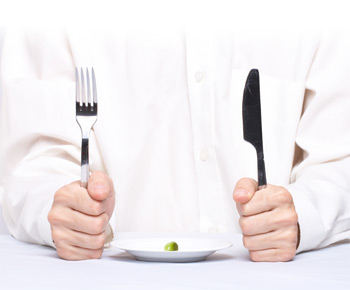 With so much media attention focused on large industry players in the financial and manufacturing sectors, the food and beverage sector has been somewhat ignored. This article provides a survival model for the small restaurant owner.
With so much media attention focused on large industry players in the financial and manufacturing sectors, the food and beverage sector has been somewhat ignored. This article provides a survival model for the small restaurant owner.
The economic downturn has affected all domestic businesses; however, media attention is focused mainly on the large players in the financial and manufacturing sectors. Rescue programs, commonly called “bail-outs,” abound, while the food and beverage sector, driven mostly by discretionary spending, is largely ignored by both the media and the government. Families are tightening their belts, and businesses are slashing travel and related expenses.
CNBC recently quoted National Restaurant Association statistics which indicated that, “Since 1990, the number of restaurants and bars has grown to 537,000 from 361,000.” That is a staggering 47 percent increase! The National Restaurant Association notes that during that period, the population has grown 23 percent. One would think that these stark differences would necessarily imply a condition of overcapacity—this was not true until September of 2008.
The proliferation of easy credit, the increase of the two paycheck family and the baby boomer generation’s desire for immediate gratification has more than absorbed the excess capacity until the economic crisis became a reality. Easy credit has since disappeared, and the rise in unemployment has changed consumer spending habits. Now, the economic reality is that the industry finds itself in a position where there is, in fact, overcapacity and less discretionary dollars to spend.
The larger chains, including Applebee’s, TGI Fridays and Olive Garden, with the national support of their respective management staffs, have the expertise to identify the core problems in the industry and the ability to make those hard economic decisions to thwart any negative impact on the bottom line. They have the economic leverage to pressure suppliers to grant price concessions as a means of further controlling their costs. They have adjusted menu offerings, controlled portions, adjusted prices, closed unprofitable locations and taken other drastic measures to ensure that their respective brands and current establishments remain viable.
Conversely, smaller family or individually owned establishments do not have the economic sophistication, the time or the tools to rapidly respond to the economic crises facing them. If these restaurateurs are to survive the short term, and remain prosperous in the long term, immediate and decisive actions are necessary. The focus of these small restaurant owners has to be on proactively managing their respective businesses in the dynamic economic environment in which we now find ourselves. This article aims to provide a survival plan to owners and managers of these smaller establishments.
The functions of management
By and large, small food and beverage establishment owners have “grown up” in the industry, and have run their respective establishments by ensuring the adequacy of their inventory (often abundant), the quality of their service and their overall reputation in the community. The key word here is “run.” The philosophy of “if you build it, they will come” has become a staple of their survival. Given the overall current economic environment, this philosophy, and the sophistication of chain competition, has rendered this business model outmoded and inadequate. The small establishment owner needs to immediately cease “running” the establishment and rapidly begin “managing” the establishment in order to survive. A contraction in sales necessarily implies that small restaurateurs must become “mean and lean,” proactively managing (as opposed to running) their businesses.
Scholars in the discipline of management science have defined four broad functions of management:
- Planning
- Organizing (including staffing)
- Directing
- Controlling
Most managers have the ability to organize their respective establishments. They hire and retain competent people. Marginal players are quickly recognized and either dismissed for cause or quickly leave by their own volition.
Similarly, these same owners are capable of directing their employees. Food preparation techniques and opening and closing tasks can be easily defined, monitored and controlled. Customer satisfaction is constantly preached and, due to the motivation of gratuities, the wait staff generally does a superb job of ensuring customer satisfaction. Effective implementation of planning and control techniques enables the smaller restaurateur to better compete with the big players in a shrinking market.
Planning
Let’s use a golfer as an example to help determine how a small restaurant owner should effectively plan. A golfer must develop a plan as to how to attain the goal, which is to get the ball in the cup within four strokes. How will he or she do that? In this example, the golfer knows the goal and must decide how to achieve it. Knowing the goal, a golfer plans for a specific club, stance and shot, then proceeds to achieve the goal. Unfortunately, many restaurateurs fail to establish specific goals. The sad fact is that a restaurateur’s goal is to make a profit. Thus, the restaurateur needs to first establish a specific goal in terms of how much profit is desired from the business.
Let’s say the restaurateur wants to earn a net profit of $50,000, or 10 percent of sales. This can be 12 percent or even 15 percent — it does not matter. At this macro level, it is important to establish reasonable goals based upon expected sales.
Once the goal is established, it must be tested for reasonableness. A net profit of 10 percent on sales requires $500,000 in sales. Is this sales goal reasonable or achievable? If it is deemed reasonable in light of economic conditions and cost structure, the answer is yes. If the answer is yes, the next phase is to then develop a strategy to achieve $500,000 in sales.
At this phase of the planning process, the owner must identify the fixed costs of the business. In this context, fixed costs are defined as the unavoidable costs of running the business such as rent, wait staff/kitchen staff costs, insurance costs, the price of cleaning supplies, etc. Fixed costs are those necessary costs that will be incurred even if sales goals are not achieved. If sales fall off, rent, insurance and skeleton kitchen and wait staff costs must still be incurred in order to keep the doors open. Generally, fixed costs cannot be controlled. To some extent, the cost of people can be controlled, but for planning purposes, these costs will be considered fixed in relation to the sales goal. In fact, they are semi-fixed costs, and controlling them in relation to sales will be addressed later.
Using this example, let’s assume that total unavoidable fixed costs are $150,000, or 15 percent of sales. (When estimating these costs, it is important to impute an inflationary adjustment over prior years.) Let’s also assume that to achieve this sales goal of $500,000, a wait/kitchen staff amounting to $150,000 is needed, which amounts to another 15 percent of sales. Table 1 depicts such a scenario.
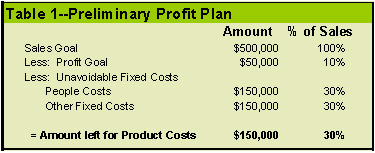
Notice that the model in Table 1 puts profits first, recognizes unavoidable costs second and relegates controllable costs to the necessary variable in achieving the goal.
The next task for the restaurateur is to do some price testing to determine if the remaining goal, food/beverage costs as a percentage of sales and resulting menu prices are reasonable and competitive in view of attaining the profit goal. If not, overhead and sales goals must be reevaluated.
The next logical step is to identify the cost of each offering in relation to the price that can be obtained in the marketplace. Table 1 implies that food and beverage cost must be limited to a level of no more than 30 percent of the published price. Reasonable due diligence is required to accomplish this task. The major chains do this routinely. Unfortunately, the small restaurateur is sometimes woefully negligent.
In order to scientifically test prices and, more importantly, to make analytical determinations concerning prices, it is obviously conducive to “plate cost” menu offerings quarterly. Table 2 depicts a simple example. However, keep in mind that the underlying assumptions are based upon the fact that offering is sold equally. In reality, however, this table, in real time, should be expanded and weighted to reflect the number of actual offerings served or anticipated to be served each year.
If the overall weighted percentage yields a product cost consistent with Table 1, the pricing is adequate with respect to the goal. If not, one must adjust pricing or rethink overall sales goals or overhead structure. Although the data presented in these tables is simplified, it does demonstrate the necessary planning steps needed to ensure attainment of the profit goal.
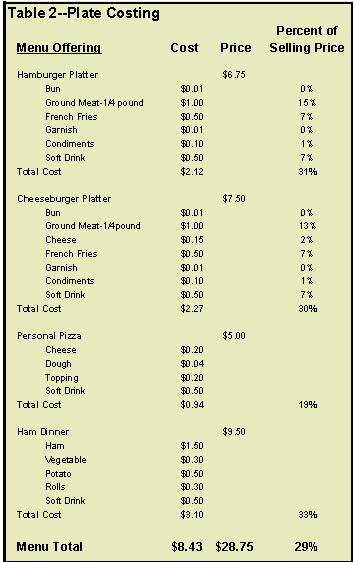
Now a sales goal, overhead goals and direct cost goals have been established in the overall plan. Notice, however, that the overall goal to control the cost/price ratio is 30 percent. Table 2 yields a metric of 29 percent. This is because, in any establishment, there will undoubtedly be waste, spoilage and mistakes. These factors must be recognized in order to make the plan achievable. The model presented recognizes this fact and defines/limits a waste and spoilage metric to be one percent. The recognition of this factor must be reflected in the planning process.
Using the previously mentioned example of the professional golfer, the “par” of the operation has now been established—a factor that is absolutely necessary before “teeing off ” or executing the plan. There is now an analytical base to judge performance effectiveness. A “budget” is in place to measure performance against par. See Table 3.
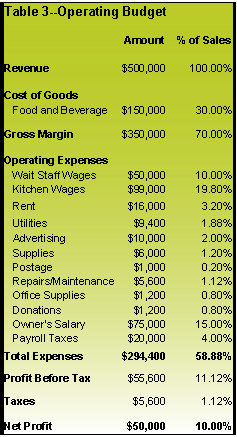 Consider a budget the “par” line on the scorecard. A golfer has 18 holes to achieve par. Some may be birdies, while others may be bogies or double bogies. At the end of the game, however, the golfer knows how he performed. As such, scorekeeping is a necessary part of the control function.
Consider a budget the “par” line on the scorecard. A golfer has 18 holes to achieve par. Some may be birdies, while others may be bogies or double bogies. At the end of the game, however, the golfer knows how he performed. As such, scorekeeping is a necessary part of the control function.
Control
Consider the golfer once again. The golfer controls his game as a means of achieving the score. He picks the right club for the shot, he executes the shot, assesses his success, adjusts his stance, checks the wind and hazards, chooses another club and shoots again. At the conclusion of the hole, he records his score. In short, he controls his game during execution of the plan in order to achieve the goal.
Execution of a restaurateur’s plan requires constant assessment of the effectiveness of actions taken before the final score is tallied. As the cost of food and beverages is the single largest line item in the plan, it must be constantly monitored and controlled.
Recall that a one percent waste/spoilage factor was incorporated in the pricing plan. If waste/spoilage exceeds this threshold, the plan will not be achieved and, all other items being equal, amounts in excess of one percent will come out of the profit goal.
An item cannot be controlled unless it is measured. Therefore, a waste and spoilage log must be posted daily in the kitchen. Employees should be instructed to record what was spoiled, thrown away and/or sent back by customers. The quantity and reason should also be recorded. That way, the restaurateur can assess the reasons and readjust purchasing practices, reduce pre- prepared items and/or adjust purchasing. To be effective, employees should be assured that no negative consequences will result by admitting errors. Otherwise, employees may be reluctant to record the situation in the log. The waste and spoilage log should be reviewed daily, and quick corrective actions should be initiated the very next day. Less money will be lost if the situation is swiftly resolved.
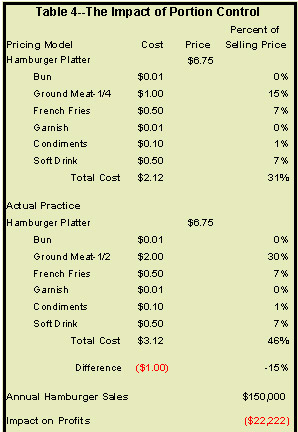 One of the most important control techniques is portion control. Consider this: if a half-pound of ground meat is routinely used rather than the pricing model’s metric of one-fourth of a pound, profits could potentially be significantly impacted as illustrated in Table 4.
One of the most important control techniques is portion control. Consider this: if a half-pound of ground meat is routinely used rather than the pricing model’s metric of one-fourth of a pound, profits could potentially be significantly impacted as illustrated in Table 4.
Though the example illustrated in Table 4 may be extreme, it does demonstrate the urgent necessity of measuring portions against predetermined standards. This practice has long been utilized by McDonalds, Burger King, Applebees, TGI Fridays, Olive Garden and other national chains. However, some smaller, independent restaurants do not even have scales in their kitchens!
Another element of control can be found in the garbage. Take note of the food discarded by customers. If french fries are consistently seen in the garbage, cut down on the portion. This action alone will add margin dollars to the bottom line.
Establishments that serve liquor are particularly vulnerable to losses due to portion control. In quest of significant gratuity, bar servers will typically be generous when it comes to the amount of liquor they pour. They may purposely pour two ounces rather than one. If a drink costs $.50 and sells for $2.00, the margin should be $1.50. However, if the drink costs $1.00 and sells for $2.00, the margin is $1.00, a 33 percent difference. To avoid this, the practice of “free pouring” should be strictly prohibited with appropriate sanctions imposed for policy violation. Drinks should be measured in a shot glass or a controlled pour device. “Comp” drinks should never be permitted except with specific authorization of the owner.
There is one final item that needs to be addressed and that is fraud and abuse. Fraud has a very significant impact on profits.
Two common fraudulent practices are as follows:
- Not ringing up the sale, discarding the ticket and pocketing the money.
- Outright theft of food and/or liquor.
There are simple controls to prevent or detect these situations.
- Use duplicate pre-numbered tickets. Record ticket number ranges given to wait staff. At the end of the day, reconcile kitchen tickets with register tickets. Identify missing tickets and resolve discrepancies. Unused and voided tickets should be returned to the office. Also, reconcile the tickets’ totals with the total sales recorded on the register.
- Another effective technique is calculating inventory once a week. Beginning inventory, plus purchases and less sales should equal the ending inventory. If lack of system sophistication prevents this, periodic, manual inventories should be taken and reconciled to the last periodic inventory. Also, employee parking should be prohibited near the kitchen door. If deemed affordable, a surveillance camera should be purchased and installed.
At the end of the first hole, a golfer records his or her score to determine where he or she stands in relation to par. At the end of the second hole, the score is recorded and the over results are tabulated and analyzed to determine overall performance after two holes. A restaurateur should do the same. Using a simple accounting system, or the services of an independent bookkeeper, the budget variance report (or scorecard) should be prepared and analyzed. Table 5 depicts gross margin performance after the second month of recording.
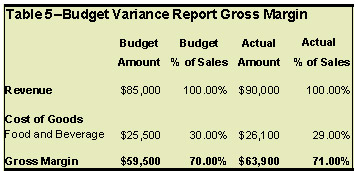 In Table 5, gross margin performance is shown separately, as the gross margin should not be measured on a fixed basis. Since food and beverage costs vary directly with sales, the sales figure drives the budget. The budget amount varies directly with the level of sales. Notice that in the aggregate, the actual amount exceeds the budget amount; yet, there is a favorable variance because sales exceeded the goal and, in this example, the cost of goods sold, as a percentage of sales, was favorable.
In Table 5, gross margin performance is shown separately, as the gross margin should not be measured on a fixed basis. Since food and beverage costs vary directly with sales, the sales figure drives the budget. The budget amount varies directly with the level of sales. Notice that in the aggregate, the actual amount exceeds the budget amount; yet, there is a favorable variance because sales exceeded the goal and, in this example, the cost of goods sold, as a percentage of sales, was favorable.
The same is true with respect to semi-fixed costs. Table 6 depicts semi-fixed costs. This cost varies with sales, but when sales reach zero, there will still be a skeleton staff. Nevertheless, sales dollars should drive the budget, and the metric to measure these costs should be based upon a percentage of sales.
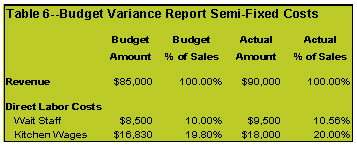 In Table 6, there is a slightly unfavorable cost in both labor categories. These should be analyzed. Was the establishment overstaffed? Why? Was overtime incurred? Why? Similar to the example of the golfer, the key here is to assess and adjust.
In Table 6, there is a slightly unfavorable cost in both labor categories. These should be analyzed. Was the establishment overstaffed? Why? Was overtime incurred? Why? Similar to the example of the golfer, the key here is to assess and adjust.
Next, it should be determined where fixed costs stand. Since fixed costs have no relation to sales, a baseline is needed to assess plan performance. One method is to monitor fixed assets in relation to the overall budget and assess their reasonableness. The “left to spend” method is one way of doing this. For example, if $12,000 in advertising is budgeted, at the end of two months, $4,000 was spent; therefore, $8,000 remains for the remainder of the year. This analysis is illustrated in Table 7.
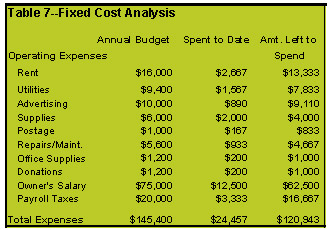 Now, the scorecard is complete. Food cost performance can be gauged, and adjustments can be made to achieve a certain goal. Labor costs can be controlled in relation to sales, and a spending guideline with respect to sales is in place. Again, these are critical management tools that larger chains use routinely.
Now, the scorecard is complete. Food cost performance can be gauged, and adjustments can be made to achieve a certain goal. Labor costs can be controlled in relation to sales, and a spending guideline with respect to sales is in place. Again, these are critical management tools that larger chains use routinely.
The final step is to consolidate these diverse elements to see if overall performance can be accurately gauged. Recall that the overall profit goal was to earn a pre-tax profit of 11 percent to 12 percent. Table 8 illustrates the fact that after two months, this goal can in fact be achieved.
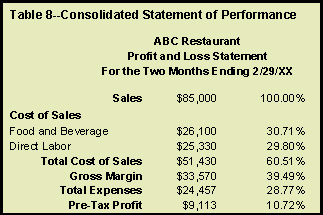 At this point, a restaurateur can not only see the big picture, but can also analyze the sum of its parts and define and implement strategies to get back on track. Not unlike the golfer, the par is known, and it is up to the owner to assess and adjust to achieve the goal. Business is not unlike golf, hockey or any other sport, as the goal must be known up front. Henry David Thoreau may have summarized it best when he said, “In the long run, men hit only what they aim for.”
At this point, a restaurateur can not only see the big picture, but can also analyze the sum of its parts and define and implement strategies to get back on track. Not unlike the golfer, the par is known, and it is up to the owner to assess and adjust to achieve the goal. Business is not unlike golf, hockey or any other sport, as the goal must be known up front. Henry David Thoreau may have summarized it best when he said, “In the long run, men hit only what they aim for.”

